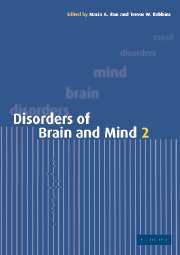Book contents
- Frontmatter
- Contents
- List of contributors
- Preface
- Part I Genes and behaviour
- 1 Genes and behaviour: cognitive abilities and disabilities in normal populations
- 2 Genes and behaviour: finding a genetic substrate for cognitive neuropsychiatry
- Part II Brain development
- Part III New ways of imaging the brain
- Part VI Imaging the normal and abnormal mind
- Part V Consciousness and will
- Part IV Recent advances in dementia
- Part VII Affective illness
- Part VIII Aggression
- Part IX Drug use and abuse
- Index
- Plate section
- References
1 - Genes and behaviour: cognitive abilities and disabilities in normal populations
from Part I - Genes and behaviour
Published online by Cambridge University Press: 19 January 2010
- Frontmatter
- Contents
- List of contributors
- Preface
- Part I Genes and behaviour
- 1 Genes and behaviour: cognitive abilities and disabilities in normal populations
- 2 Genes and behaviour: finding a genetic substrate for cognitive neuropsychiatry
- Part II Brain development
- Part III New ways of imaging the brain
- Part VI Imaging the normal and abnormal mind
- Part V Consciousness and will
- Part IV Recent advances in dementia
- Part VII Affective illness
- Part VIII Aggression
- Part IX Drug use and abuse
- Index
- Plate section
- References
Summary
Introduction
During the past three decades, the behavioural sciences have emerged from an era of strict environmental explanations for differences in behaviour to a more balanced view that recognizes the importance of nature (genetics) as well as nurture (environment). This shift occurred first for behavioural disorders, including rare disorders such as autism (0.001 incidence), more common disorders such as schizophrenia (0.01), and very common disorders such as reading disability (0.05). More recently it has become increasingly accepted that genetic variation contributes importantly to differences among individuals in the normal range of variability as well as for abnormal behaviour. Moreover, many behavioural disorders, especially common ones, may represent the quantitative extreme of the same genetic and environmental factors responsible for variation in the normal range. That is, genetic influence on disorders such as reading disability may not be due to genes specific to the disorder but rather to genes that contribute to the normal range of individual differences in reading ability. This view, known as the quantitative trait locus (QTL) perspective, has important conceptual implications because it implies that some common disorders may not be disorders at all but rather the extremes of normal distributions. This QTL perspective has far-reaching implications for molecular genetics and for neuroscience. If many genes of small effect are involved, it will be much more difficult to find them. It will also be much more difficult to explore the brain mechanisms that mediate genetic effects on behaviour.
- Type
- Chapter
- Information
- Disorders of Brain and Mind , pp. 3 - 29Publisher: Cambridge University PressPrint publication year: 2003
References
- 2
- Cited by



